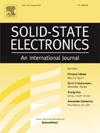Analog behavior of forksheet FET at high temperatures
IF 1.4
4区 物理与天体物理
Q3 ENGINEERING, ELECTRICAL & ELECTRONIC
引用次数: 0
Abstract
This work presents an experimental study of the analog behavior of forksheet FET from room up to 150 °C with channel lengths of 26 and 70 nm. These devices present a Zero Temperature-Coefficient (ZTC) point for a gate voltage around 0,59 V (VZTC) in saturation region. The threshold voltage variation with temperature (dVT/dT) is around −0,5mV/oC due to the Fermi level decrease. The DIBL increases with temperature but it is kept lower than 51 mV/V in the studied temperature range. The transconductance and output conductance decrease (mainly due the mobility degradation) which results in a good intrinsic voltage gain of around 36 dB at room temperature, showing a slight change (±2dB) in the studied temperature range. The maximum unity gain frequency estimated for L = 26 nm is around 358 GHz in strong inversion regime. The results show that the forksheet FETs present a good performance for analog applications at high temperature, which in addition to the already known savings in footprint area compared to nanosheet technology, are potentially useful for future mixed-signal integrated circuits.
高温下叉片场效应管的模拟行为
这项工作提出了一个实验研究的模拟行为的叉片场效应管从房间到150°C,通道长度为26和70纳米。这些器件在饱和区栅极电压约为0.59 V (VZTC)时呈现零温度系数(ZTC)点。由于费米能级的降低,阈值电压随温度的变化(dVT/dT)在−0,5 mv /oC左右。DIBL随温度升高而升高,但在研究温度范围内保持在51 mV/V以下。跨导和输出电导降低(主要是由于迁移率下降),导致室温下的固有电压增益约为36 dB,在研究的温度范围内略有变化(±2dB)。在强反转区,L = 26 nm的最大单位增益频率估计在358 GHz左右。结果表明,叉片fet在高温下的模拟应用中表现出良好的性能,除了已知的与纳米片技术相比节省的占地面积外,还可以用于未来的混合信号集成电路。
本文章由计算机程序翻译,如有差异,请以英文原文为准。
求助全文
约1分钟内获得全文
求助全文
来源期刊

Solid-state Electronics
物理-工程:电子与电气
CiteScore
3.00
自引率
5.90%
发文量
212
审稿时长
3 months
期刊介绍:
It is the aim of this journal to bring together in one publication outstanding papers reporting new and original work in the following areas: (1) applications of solid-state physics and technology to electronics and optoelectronics, including theory and device design; (2) optical, electrical, morphological characterization techniques and parameter extraction of devices; (3) fabrication of semiconductor devices, and also device-related materials growth, measurement and evaluation; (4) the physics and modeling of submicron and nanoscale microelectronic and optoelectronic devices, including processing, measurement, and performance evaluation; (5) applications of numerical methods to the modeling and simulation of solid-state devices and processes; and (6) nanoscale electronic and optoelectronic devices, photovoltaics, sensors, and MEMS based on semiconductor and alternative electronic materials; (7) synthesis and electrooptical properties of materials for novel devices.
 求助内容:
求助内容: 应助结果提醒方式:
应助结果提醒方式:


